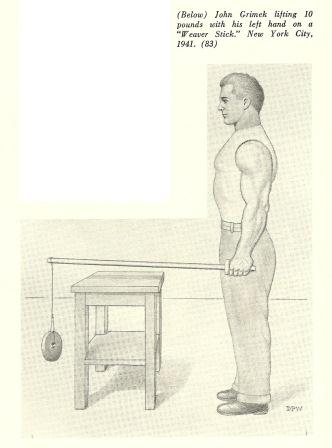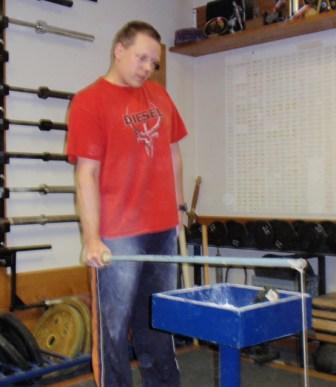The Weaver Stick Controversy
by Al Myers

John Gallagher demonstrating the Weaver Stick, the lift made popular by George Weaver. This photo was in an article written by Weaver, in which he said "demonstrates the proper method of lifting the Weaver Stick". Take notice of the bent arm and non-upright body position. This makes me wonder - was this the way he INTENDED the Weaver Stick to be done?
Yesterdays Daily News Story by the famous strength historian David Willoughby was just a “set up” for today’s story. In it, he described the origins of the Weaver Stick and the foundation for the Weaver Stick rules. I feel the Weaver Stick is a misunderstood (most don’t know how to even MAKE a Weaver Stick) lift of the All-Rounds, and after what I reveal today it will now not just be misunderstood, but will be a controversial lift as well. I have written blogs on the Weaver Stick before and have went over its historical significance in the USAWA. I have even covered the best lifts ever done in the USAWA using the Weaver Stick. That is not what today’s story is about. This lift was part of my grip meet a few years ago as well. So I know there are several lifters who are familiar with it. I was introduced to the Weaver Stick for the first time when I went to Clarks Gym years ago for a record day. After putting up “BIG LIFTS” all day for records in several full body type lifts, Bill brought out his Weaver Stick to “humble us”. It did the trick. I could barely lift 5 pounds! I then went home and made my own Weaver Stick, which still resides in the corner of the Dino Gym for anytime I feel like “humbling someone”. Ole Clark did it to me – and now I’m returning the favor!
But what’s the controversy you ask? Well, lets go over both the USAWA Rules and the IAWA Rules and you’ll soon find out!
USAWA RULE I26. Weaver Stick
A Weaver Stick is used for this lift. The Weaver Stick utilizes a wooden broomstick with these dimensions. The handle is 5 ½ inches in length. The junction of the handle and the rest of the Weaver Stick may be marked with tape, or with any material that is raised to provide a distinct separation between the handle and the rest of the stick. This marking is ½ inch in length. At a point exactly 36 inches from the end of the marking, or 42 inches from the end of the handle, a notch is made in the stick to allow a cord to be attached to it. This cord may be of any length. Weight is tied onto the end of the cord. The Weaver Stick must rest on a flat lifting surface with the weight hanging free. The lift will begin at the lifter’s discretion. The lifter will take a position alongside the Weaver Stick, and grip the handle of the Weaver Stick by one hand, facing the length of the stick. The lifting hand and arm must remain straight with elbow fully locked, and must not be in contact with the body during the lift. The lifting arm must remain at the lifter’s side throughout the lift. The heel of the hand must remain on top of the Weaver Stick. If the hand twists under the stick during the lift, it is a disqualification. The non-lifting hand must not touch the lifting arm, lifting hand, or Weaver Stick during the lift. The lifter’s body must be upright with legs straight at the completion of the lift, but the legs may bend when picking up the stick. The Weaver Stick must be lifted entirely clear from the lifting surface while maintaining the stick parallel to the floor. If the end of the stick containing the weight dips to any degree, it is a disqualification. If the lifting hand moves to a position in front of the handle marking during the lift, it is a disqualification. Once the Weaver Stick is motionless, an official will give a command to end the lift. Records are also kept for the Weaver Stick with the lifter facing backwards, away from the length of the stick.
IAWA RULE F9. WEAVER STICK LIFT
This lift can be performed with either hand, and to the front or the rear. The lifter will use a 36 inch long stick, it will have a notch half an inch from one end where the weight will be suspended or attached. The stick will be gripped a full 36 inches away from the weight, with one hand. The stick will be set down on a chair or table, the lifter must lift the stick off the surface parallel to the floor and not with the weighted end tilting down. There is no minimum height that it has to be lifted, just clear of the table. It must be lifted straight up, no rocking motions are allowed. The lifting hand and arm must remain free of the body, and the heel of the hand must remain on top of the stick, the hand is not allowed to twist around the stick. When the stick is held clear of the table and motionless the referee will signal to replace the bar. A hand grip guard can be made using two metal right angles, screwed to the stick in such a manner as to prevent the hand from being closer than 36 inches. The handle can be taped around to suit the lifters hand and afford a good grip.
Causes for Failure:
1. Failure to keep the stick held parallel (approx.) to the floor at all times during the lift.
2. Touching the body with the lifting hand or arm and failing to keep the heel of the hand on top.
3. Failure to lift the stick clear of the chair or surface, under control.
4. Lowering / replacing the bar before the referees signal.
Do you notice the BIG DIFFERENCE between the USAWA rule and the IAWA rule???????
It’s a BIG ONE – the IAWA rule for the Weaver Stick DOES NOT require the arm to be straight!!! It can be bent to any degree. Let me “tell ya” – that’s a big difference! Much more weight can be lifted with the Weaver Stick if the arm does not have to remain straight. Bending the arm allows other arm muscles to come into play and helps with the wrist stabilization. I am sure most USAWA lifters are not aware of this IAWA rule for the Weaver Stick. I know I wasn’t until IAWA President Steve Gardner and I got into this discussion during one of our “beer drinking sessions” a few days after the IAWA Worlds in Australia. He was not aware that the USAWA required a straight arm either (just as I was not aware that the IAWA allowed a bent arm) – as we have since the beginning. Maybe this all arose because of the misinterpretation of Weaver’s account by Willoughby. Re-read yesterdays story and you will now notice that he didn’t mention at ANY TIME the arm must be straight. But at the same time he referenced that drawing of Grimek as the “correct position” using the Weaver Stick, and in it John Grimek’s arm is as “straight as an arrow”. Now I can only imagine at this point in this story Weaver Stick extraordinaire Tom Ryan is getting out of his chair and ready to give someone “a thrashing” with HIS Weaver Stick for insulting the Weaver Stick Rule this way. After all, I witnessed Tom set his big Weaver Stick ALL-TIME USAWA RECORD of 7 pounds at a record day in Clarks Gym in 2002. I also remember very clearly that Tom’s arm was very straight when he did it, as Bill Clark was officiating him and wouldn’t let “nothing bend” on the issue of requiring a straight arm. That’s how it has always been in the USAWA. I contested the Weaver Stick at my 2010 Grip Challenge at my gym, and close to a dozen good “grip guys” tested on it. I was the judge, and judged it as hard as Bill would have. Grip sensation Andy Durniat lifted 6 pounds, along with my father LaVerne (everyone was surprised with that one!). But ole Dad has spent a lifetime of building his grip doing farm work, and it paid off with building the right muscles for the Weaver Stick. These were the top Weaver Stick lifts of the day, and both very solid and reputable lifts with the Weaver Stick using a straight arm. This meet sure reiterated the great Weaver Stick Record of 7 pounds done by Tom Ryan.
We (the USAWA) have made great strides in the past couple of years to get our USAWA rules into compliance with the IAWA rules. We have been changing ours to met theirs. But this is one I would argue that we have RIGHT – as any rule should represent THE INTENT of the original development of the lift. I truly feel Weaver intended for the Weaver Stick be done with a straight arm and NOT a bent arm. Or did he INTEND it to be done with a bent arm???? That’s the controversy.
One thing is for certain – officiating the Weaver Stick with a bent arm allowed would be a whole lot easier. Making the decision of “red lighting” a lift on arm bend is very subjective. Bill Clark once told me this, “officiating the bend of the arm in the Weaver Stick is as subjective as judging the depth of a squat!”. I couldn’t agree more. Please let your opinion on this be known in the USAWA Discussion Forum (and Tom you can lead the way with this discussion!).

